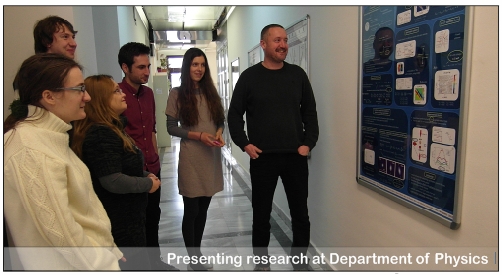O B A V I J E S T
PRIYANKA REDDY
održat će znanstveni kolokvij (doktorski seminar) iz Fizike kondenzirane tvari pod naslovom
Novel electronic materials on the verge of metallicity and ionicity
Contemporary investigations of functional complex materials focus on two key questions: the nature of the metal-insulator (MI) transition and the metal-insulator-superconductor (MI-SC) transition. The challenge in understanding these materials arises from their nature, which lies in a complex crossover regime between well-established chemical (ionic/covalent) and physical (localized/Fermi liquid) concepts. To understand these materials, one needs to interpolate between textbook limits, allowing for the interaction between these regimes and the resulting evolution of chemical bonding, which can naturally lead to the emergence of distinct electronic subsystems.
Murunskite compound, K2FeCu3S4, occupies a unique position among functional materials, acting as an intermediary between high-temperature superconducting cuprates and pnictides[1]. Recently we have reported, the very first, recipe for growth of the first large high-quality single crystals. Structural characterizations confirmed the phase purity of obtained single crystals and revealed a random distribution of iron and copper within the murunskite parent compound. Furthermore, these crystals underwent extensive physical and chemical characterization. The as synthesized murunskite is identified as a quasi-2D semiconductor with a band gap of Eg = 0.9 eV, as determined by transport and optical spectroscopy measurements agreeing well with the predictions of Density Functional Theory (DFT) calculations. Contrary to the proposed K2Fe³⁺Cu3⁺S4 oxidation states, X-ray Photoemission Spectroscopy (XPS) indicated that iron is in a mixed oxidation state, with Fe²⁺ being the dominant species, due to iron reduction linked to the opening of sulfur orbitals. DFT calculations further revealed that the valence and conduction bands are dominated by copper and iron, respectively, with ligand orbitals significantly contributing to the bands just below the gap. Magnetically, murunskite exhibits complex antiferromagnetic-like (AF) behavior, with a well-defined transition at 97 K and 2D AF correlations appearing below 150 K. The magnetic moments order in two sub-lattices with two related incommensurate k-vectors [2]. Mössbauer spectroscopy identified two distinct nuclear iron sites at room temperature, providing a comprehensive explanation of the magnetic structure of murunskite.
Following the successful growth of single crystals of the parent compound, further development was pursued through two primary approaches: chalcogen substitution and electron doping at the iron site. Substituting sulfur with tellurium resulted in seven orders of magnitude decrease in electrical resistivity, accompanied by significantly weaker antiferromagnetic 2D correlations. Similarly, cobalt substitution at the iron site led to further modifications in the material's electronic and magnetic properties, notably inducing superconductivity at 2.6 K. Infrared spectroscopy was employed to gain a deeper understanding of these systems, with results aligning well with theoretical concepts and interpretations.
Additionally, a novel technique, ionic gel gating, was applied, leading to a further decrease in resistivity by several orders of magnitude. High-pressure measurements were also conducted as part of this dissertation, broadening the scope of the study to explore the effects of external pressure on the material's properties. These investigations provide critical insights into the tunability of murunskite and related compounds, contributing to the broader understanding of functional materials with potential applications in electronic, magnetic, and superconducting devices.
Seminar će se održati u ponedjeljak 28. listopada 2024. godine u 11:00 sati u predavaonici F-201 Fizičkog odsjeka Prirodoslovno-matematičkog fakulteta Sveučilišta u Zagrebu.
Pozivaju se studenti doktorskog studija Fizike, smjer Fizika kondenzirane tvari, da prisustvuju seminaru, ako nisu spriječeni.
Voditeljica smjera:
Prof. dr. sc. Ana Akrap, v. r.


 Pristupačnost
Pristupačnost